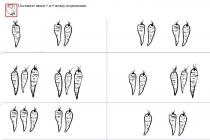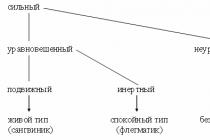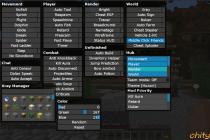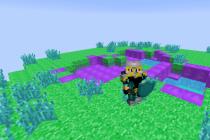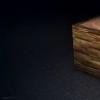EMBRYOLOGY
Developmental biology (embryology) - the science of the patterns of ontogenesis of multicellular
organisms from gametogenesis to post-embryonic development. Developmental biology studies the structure and functions of embryos at successive stages of development up to the formation of adult forms and subsequent aging of the organism. Development is under the control of genetic factors and factors environment, it is regulated at the level of the whole organism, the rudiments of organs and tissues, at the cellular, subcellular, and molecular levels.
Developmental biology is based on the achievements of related sciences - cytology, genetics, molecular biology, evolutionary theory and ecology. Therefore, the presentation of the course "Embryology" is supplemented with the necessary information from the disciplines listed above.
Subject and history of embryology
The subject of embryology, its relationship with other biological disciplines. Short review history of embryology. The views of Hippocrates and Aristotle. Embryology of the 17th-18th centuries.
Preformists and epigenetics. Works by K.F. Wolf. Development of embryology in the 19th century. Significance of K. Baer's works. The influence of Darwinism on embryology. Comparative evolutionary direction (A.O. Kovalevsky, E. Haeckel, I.I. Mechnikov). Historical roots of experimental embryology, its modern tasks. The causal-analytical method, its strengths and weaknesses. Discussion of neopreformists and neoepigenetics (V. Gies, V. Roux, G. Driesch). The main directions and tasks of modern descriptive, experimental, comparative and theoretical embryology. Its connection with cytology, genetics and molecular biology.
Applied value of embryology.
Embryology is a science that studies the individual development of a multicellular organism, as well as the patterns of changes in its morphofunctional state throughout ontogenesis.
It includes certain sections of cytology, histology, genetics and molecular biology. One of the beginnings of embryology, apparently, was obstetric practice (as one of the first forms of medical care). The second principle is ideological (empirical - movement from fact to fact and theoretical - a general idea of the emergence of life, the origin, development of the organism).
The first theories, which later served as the basis for the development of science, appeared in antiquity.
Empedocles (444 BC) claimed that a person is formed from 31 days to 50. He believed that bones are earth and water, sinews are earth and air, etc. He also believed that the birth of twins or freaks is the result of the work of the mother's imagination. He believed that the fetus begins to breathe from the moment of birth.
Diogenes argued that the placenta is the organ of nutrition of the embryo. And he expressed the idea of a consistent development of structures.
Hippocrates - the first regular knowledge in the field of embryology. (460-370 BC) Mainly associated with obstetrics and gynecology. Proceedings "On diet", "On the seed", "On the nature of the child." He talks about the three inherent properties of every body - dryness, moisture, warmth. They never meet separately. Hippocrates compares all processes in the body with processes in inorganic bodies and with labor activity.
He expressed the idea of preformation: “All parts of the embryo are formed at the same time. All members separate from each other at the same time and grow in the same way. None arises earlier or later than the other, but those that are by nature thicker appear before thin ones, not having been formed before ”(Preformism - everything is determined from the very beginning)
Aristotle (384-322 BC) laid the foundation for general and comparative embryology. Work "On the Origin of Animals". He opened chicken eggs, dissected and studied all kinds of embryos of cold-blooded animals and mammals, and even, possibly, abortive human embryos. (Epigenesis - everything re-emerges)
Aristotle:
1) He proposed the classification of animals according to embryological characteristics.
2) Entered comparative method studying and laying ideas about the various ways of embryonic development; he was aware of egg production and live birth.
3) Established the differences between primary and secondary sexual characteristics.
4) Relates sex determination to the early stages of embryonic development.
5) He put forward the concept of an unfertilized egg as a complex machine, the parts of which will begin to move and begin to perform their functions as soon as the main lever is raised.
6) Correctly interpreted the functions of the placenta and umbilical cord.
7) Connected the phenomenon of regeneration with the phenomenon of embryogenesis.
8) Anticipated the theory of recapitulation by his judgment that in the process of embryonic development, general signs appear before particular ones.
9) He proposed the theory of gradients of morphogenesis by his observations on the more rapid development of the head end of the embryo.
10) Established that the existing assumptions are reduced to the antithesis of preformation - epigenesis. He himself insisted on the correctness of the second option - epigenesis.
He also expressed the idea of 4 causes - material, active, formal and final. In the Middle Ages, the fourth, final reason prevailed, due to its connection with the idea of the divine principle.
Only Francis Bacon (1561-1626) proved it. That from a scientific point of view, the ultimate cause is an unnecessary concept. Up to this point, since the death of Aristotle, nothing has changed in embryology.
In the 17th century, Anthony van Leeuwenhoek invented the microscope. Described penetration into the uterus and tubes of spermatozoa in various living organisms.
Controversy between K. Wolf (Petersburg Academy of Sciences) and A. Haller.
Haller stood on the side of preformism, and Wolf showed, using the example of the development of the circulatory, and later the digestive systems, that at first these systems look like leaves, then like grooves, and finally turn into tubes. In 1776 he compiled the work On the Formation of the Intestine. The authority of Haller prevented the recognition of Wolff's correctness, but, over time, it was recognized.
The works of the 19th century embryologists K. Baer and H.G. Pander were built precisely on the recognition of the rightness of Wolf.
K. Baer. One of the greatest naturalists of his time. He developed Pdera's theory of germ layers, singled out the animal (giving integument and NS) and vegetative (giving blood vessels, muscles, digestive tract) poles, the germ chord.
He made an outstanding generalization that defined embryology as an independent science - the similarity in the development of embryos of higher and lower animals. The pattern was that first the characteristics characteristic of the type develop, then the class, etc.) - Beer's Law. He noticed that ontogenesis is a preformed epigenesis. (Reappears, but in a predetermined form)
Bischof gave the names of the germ layers that have survived to this day (meso-, endo- and ectoderm) Based on the teachings of T. Schwann about the cell. He showed that the leaves of the same name of different animals are similar in histological structure.
C. Darwin fueled interest in embryology. Many evolutionists have tried to use embryological evidence to support the theory of evolution.
Ernst Haeckel formulated the basic biogenetic law “The development of the embryo is a compressed and abbreviated repetition of the evolutionary development of a given group of organisms. It is the more complete, the more palingenesis is preserved (palingenesis is a feature or process in embryogenesis that repeats the corresponding feature or process of phylogenesis of a given species)
Weisman (1834-1914) used a cytogenetic approach, while before that they used only a relatively evolutionary and descriptive approach. He proposed the concept of uneven division, the allocation of the germline and unequally hereditary mitosis. Based on Boveri's experiments with roundworms. He described the phenomenon of chromatin deminution (the loss of part of the chromosomes in somatic cells).
Roux's experiments with cauterization of half of a 4-cell embryo. (Of the half, only half of the org-ma developed) However, when the halves were isolated, full-fledged org-we developed. Hans Driesch's experiments with ctenophores (both cauterization and isolation reduced the number of ridges.) It also turned out that a defect in the cytoplasm of an immature egg is corrected, and a mature one leads to disturbances in the embryo. It turned out that when removing blastomeres from annelids, molluscs develop a larva with irreparable defects, and in echinoderms, coelenterates, ascidians - a normal embryo. These are, as it were, combinations of preformism in the former and epigenesis in the latter.
The causal-analytical method has replaced the descriptive and comparative methods. Experimental and analytical embryology began to take shape.
Strengths - the ability to obtain fundamentally new information, data.
Weaknesses - (what will happen if .. The method is based on an experiment, the theory is adjusted to the result of the experiment. This method does not make it possible to understand the mechanism, we only see the result of the action.)
Driesch belonged to the neo-epigenetics, Roux to the neo-preformists.
It was Driesch who managed to establish the equipotentiality of the blastomere nuclei of some developing eggs. He found that they differ in cytoplasm. At the same time, sea urchin eggs produced absolutely identical blastomeres. Driesch concluded that the fate of blastomeres is a function of their position as a whole. (an anticipation of current beliefs about positional information). Driesch also concluded that the prospective potency of the blastomere is always wider than its prospective value (it can develop more of everything that is obtained in normal development).
Today, embryology is largely associated with genetics, molecular biology and cytology. Using the methods of these sciences allows you to delve deeper into existing issues and establish previously inaccessible details. Today, embryology has largely moved to the micro level. Experimental embryology in our time is largely curtailed in its capabilities due to the limitations imposed by bioethics.
Gametogenesis
Formation of primary germ cells (gonocytes) in various groups of animals (sponges, coelenterates, roundworms, crustaceans, vertebrates).
gonocyte, or primary sex cell- this is an embryonic cell, from which germ cells can subsequently form.
In all animals with morphologically expressed gonads, germ cells are laid down independently of the gonad (extragonadally). From the moment of isolation to the introduction into the gonad, these cells are called gonocytes.
In some animals, germ cells are able to form from somatic cells throughout ontogenesis. Such animals include sponges, coelenterates and flatworms. In sponges, germ cells are formed from amoebocytes and choanocytes. In coelenterates, germ cells are formed from interstitial (I-) cells, in flat and annelids - from neoblasts.
Therefore, germ cells can also appear in them in the case of regeneration from small areas of the body of adult animals with the complete removal of the sex glands.
In long-starved planarians, germ cells can dedifferentiate and turn into stem cells used for the regeneration of somatic tissues.
In annelids, an early separation of the rudiment of germ cells occurs, which are formed from somatic cells. Thus, they have two sources of gonocytes: early embryonic and somatic.
According to modern concepts, in other animals, the rudiment of gonocytes separates at the gastrula or neurula stage. In most roundworms, arthropods and tailless amphibians, germ cells separate already in the process of crushing.
So, in dipterous insects, even before the start of crushing, in the posterior pole of the egg, there are basophilic granules consisting of RNA and protein. Subsequently, germ cells are isolated precisely from this area of the cytoplasm. In Drosophila, the final isolation of germ cells occurs at the 13th cleavage division.
Similar granules (ectosomes) are present in the ovum of the copepod cyclops crayfish. As a result of cleavage divisions, ectosomes are distributed between two cells, which give rise to sex. Separation of germ cells occurs at the 5th cleavage division. Even earlier (at the 4th cleavage division), germ cells are isolated from branched crayfish, as well as from some roundworms.
In the horse roundworm, at the very beginning of development, during the division of somatic cells, chromatin diminution occurs (rejection into the cytoplasm and subsequent degradation of part of the chromatin). Diminution does not occur during the formation of gonocytes. Thus, the sex cells are isolated from the somatic cells, retaining their totipotency.
In fish, gonocytes separate at the end of gastrulation. Their source is the primary entomesoderm. It is possible that primary germ cells are present in the gonads of adult fish.
In the oocytes of amphibians, at the beginning of the period of oocyte growth, RNA-containing structures are found at the vegetative pole, which should be attributed to the sex cytoplasm (non-glandular cytoplasm, "germ (sex) plasm"). Gonocytes in anurans are isolated at the blastula stage, among the blastomeres of the future endoderm. At the stage of late gastrula, cells containing sex plasma are found in the inner part of the endoderm and in the region of the yolk plug. At the tail bud stage, these cells are located in the region of the dorsal endoderm. In young larvae, they remain in the endoderm for some time before entering the gonad.
The formation of gonocytes in caudate amphibians, unlike anurans, does not occur autonomously, but under the influence of neighboring embryonic tissues. Gonocytes arise at the gastrula or neurula stage. They are isolated from the mesoderm under the influence of the endoderm (such an effect is carried out even at the blastula stage).
In reptiles, primary germ cells are found in the extraembryonic endoderm.
In birds, primary germ cells arise near the posterior end of the embryo. Then they move forward to the region of the crescent head, all the time being in the extra-embryonic region. When an extraembryonic circulatory system arises, gonocytes with the blood flow move inside the body of the embryo.
Mammalian germ cells are descendants of embryonic totipotent cells present in the blastoderm of the embryo during the formation of the primitive streak. Then they enter the posterior extra-embryonic endoderm, migrate into the intestinal wall and into the surrounding mesenchyme. Then they move to the dorsal mesentery to the anlage of the gonad.
So, the only source of germ cells in vertebrates, arthropods and roundworms is the primary gonocytes, which separate in the early stages of development. However, far from all groups of animals, gonocytes cannot be replenished at the expense of somatic cells for more than late stages development. Sponges, coelenterates, some annelids and hemichordates have totipotent stem cells that replenish the supply of germ cells throughout life.
The emergence of germ cells in the process of evolution is the first differentiation of body cells. At the same time, germ cells retain their totipotency. This division was the most important evolutionary event that allowed the transition from unicellular to multicellular.
Migration of gonocytes into the gonad.
First of all, the gonocytes must reach the anlage of the gonad. Both primary gonocytes and reserve cells, such as interstitial ones, are able to move independently, but they pass a significant part of their life passively, with the blood flow. Near the rudiment of the gonad, gonocytes move actively.
At the stage of primary gonocytes, male and female germ cells are usually indistinguishable. Differences appear only after their penetration into the sex glands. At the same time, female gonocytes populate the cortical part of the gonad, and male gonocytes populate the medullary part.
Sex cells that have entered the rudiments of the gonad and begun to reproduce are called goniums(spermatogonia and oogonia).
Many animals have special stem cells that produce gonia over a long period of time (or even a lifetime). There are two types of stem cells. Some of them divide asymmetrically, as a result of which one of the daughter cells remains a stem cell, while the other takes the path of further development. So, for example, occurs in Drosophila.
In other cases (for example, in roundworms), the stem sex cells divide symmetrically, and the fate of each of them is determined by what position they accidentally occupy in the gonad.
Oogenesis, its main periods: reproduction, growth, maturation of eggs. Types of nutrition of eggs: phagocytic, nutritional, follicular. Communication between the egg and nutrient cells different types nutrition; substances entering the egg. Previtellogenesis and vitellogenesis. Prophase of meiosis, cytological and biochemical rearrangements occurring in it. Gene amplification. Synthesis of rRNA and mRNA. Polarization of the egg. Features of the divisions of the maturation of the egg.
As already mentioned, once in the gonad, gonocytes begin to reproduce by ordinary mitotic divisions. At this stage, the female sex cells are called oogonia. Oogonia stop reproducing even in the embryonic period, long before the onset of sexual maturity of the female. A five-month-old human fetus has 6-7 million. female reproductive cells. Then comes their mass death by apoptosis. As a result, by the time of birth, about 1 million cells remain, and by the time of puberty - less than 400,000 cells. By the age of 50, a woman has only about 1,000 germ cells left.
A female reproductive cell that stops reproducing is called oocyte I order. A peculiar, peculiar only to this cell, period of growth begins. It is associated with the entry of nutrients into the egg from the outside and with a number of synthetic processes in the egg itself. The increase in the egg during growth can be enormous. So Drosophila oocytes increase 90,000 times in 3 days. In mammals, oocytes increase in volume by more than 40 times. The growth of a mammalian egg can take decades. For example, in a person - up to 30 years.
Oocyte growth is usually divided into two periods. The period of small growth (previtellogenesis or cytoplasmic growth) and large growth (vitellogenesis, trophoplasmic growth).
For period short stature a relatively small and proportional increase in the nucleus and cytoplasm is characteristic, in which the nuclear-cytoplasmic ratio does not change. The entire period of previtellogenesis passes against the background of cell preparation for subsequent maturation divisions. At this stage, the oocyte of the first order enters the S-phase, that is, the phase of DNA duplication. This is followed by the prophase of the 1st division of meiosis. At this stage, chromosome conjugation, the formation of a synaptonemal complex, and crossing over occur. In the nucleus of the oocyte, the stages of leptotene, zygotene, pachytene, and diplotene pass successively. At the stage of diakinesis, a stationary phase begins, while the further course of meiosis slows down greatly or stops completely. This meiotic block continues until the individual reaches maturity. However, at this stage, the oocyte DNA is active. It acts as a template for the synthesis of all types of RNA. These RNA molecules are mainly synthesized for use by the egg after fertilization.
Synthesis of rRNA is associated (28S and 18S) with the phenomenon of amplification of the genes encoding these types of RNA. The amplified parts are isolated in the form of nucleoli, which can be several thousand. Amplification occurs mainly at the stage of pachytene. After maturation of the oocyte, the nucleoli enter the cytoplasm of the cell and lyse there.
Synthesis of 5S-rRNA and tRNA occurs without amplification due to the fact that the genes encoding them are repeated many times.
The synthesis of mRNA is associated with the acquisition of the "lampbrush" structure by the oocyte chromosomes. At the same time, the period of "lamp brushes" is observed in oocytes with solitary and follicular types of nutrition. In other cases, this period is shortened or absent. The mRNA molecules stored for the development of a fertilized egg are present in the oocyte cytoplasm in the form of informosomes, a complex of mRNA with proteins.
Period big stature characterized by strong growth of cytoplasmic components. The nuclear-cytoplasmic ratio decreases in this case. During given period in the oocyte of the first order, the yolk (lat. Vitellus) is deposited in the form of granules, as well as other nutrients: fats and glycogen.
According to the amount of yolk deposited, the eggs are divided into:
ñ polylecithal(multi-yolk), found in most arthropods, fish and birds;
ñ mesolecithal(with an average amount of yolk), found in amphibians and sturgeons;
ñ oligolecithal(small yolk), found in most worms, in molluscs and echinoderms;
ñ alicetal(yellowless), found in mammals and some forms of invertebrates.
The amount of zhedk in the cell is strictly determined genetically and almost does not depend on the feeding conditions of the female.
According to the nature of the location of the yolk, the egg is classified into:
ñ isolecithal(oligo- and mesolecithal)
ñ telolecithal(polylecithal - bony fish, mesolecithal - amphibians)
ñ centrolecithal(polylecithal - insects)
According to the method of formation, the yolk is divided into:
ñ exogenous yolk is built on the basis of a precursor protein - vitellogenin, which enters the oocyte from the outside (in vertebrates, it is synthesized in the mother's liver and is under hormonal control: the hypothalamus secretes the hormone luliberin, under the influence of which the pituitary gland secretes FSH and LH into the blood, in response to this, follicle cells synthesize estrogen, which regulates the synthesis of vitellogenin by liver cells both at the transcription level, as well as at the translation level). Yolk granules are already formed inside the oocyte itself. During the formation of yolk granules, vitellogenin is cleaved into a highly phosphorylated fosvitin protein containing 8% phosphate, and a lipovitellin protein containing up to 20% lipids. The structural unit of the yolk plate is formed by one molecule of lipovitellin and two molecules of phosphitin.
ñ endogenous yolk, which is synthesized from low molecular weight precursors within the oocyte itself. Only a few types of eggs develop solely from the endogenous yolk.
In the course of evolution, there is a transition from facultative hypertrophy of the parent cell of the future organism to obligatory hypertrophy.
There are the following ways of feeding the eggs:
ñ diffuse(phagocytic) is described in sponges and freshwater hydra. The growing oocyte engulfs smaller cells by phagocytosis. For some time, the nucleus of phagocytosed cells can maintain synthetic activity, supplying the oocyte with mRNA copies. The engulfed cells then die by apoptosis. The main biochemical process in the cytoplasm of such an oocyte is the synthesis of hydrolytic enzymes for the digestion of phagocytosed material, which is deposited in phagolysosomes. With this type of nutrition, true yolk granules are not formed.
ñ solitary(single) type of nutrition occurs when the oocyte is not directly associated with any other cells and receives all the necessary substances from the environment in a low molecular weight form. This type of nutrition is found in colonial hydroid polyps, starfish, lancelet and other species. In this case, the yolk and all types of RNA are synthesized by the oocyte itself, that is, the yolk is endogenous.
ñ alimentary, that is, carried out with the help of auxiliary cells. Subdivided into:
u nutritional the type of nutrition appears in various groups of worms and reaches its highest development in arthropods. In this case, the oocyte is surrounded by special feeding cells - trophocytes, connected with the oocyte by cytoplasmic bridges. Trophocytes and oocytes arise from the same nest of breeding oogonia. The fate of oogonial cells is determined by the number of connections (cytoplasmic bridges) with other cells. The main function of trophocytes is the synthesis of rRNA entering the oocyte. Trophocytes have nothing to do with the synthesis of yolk. The main part of yolk proteins in the nutritional mode of nutrition is synthesized in somatic cells and enters the oocyte through pinocytosis.
u follicular the type of nutrition is the most common and perfect and is found in a number of invertebrates and most chordates. It reaches a special development in mammals. This type of nutrition is associated with the formation of one or more layers of the follicular epithelium surrounding the oocyte from the somatic cells of the gonad. The oocyte together with the follicular epithelium, which is separated from the oocyte by the periocyte space, is called the follicle. The follicular type of nutrition can be combined with the nutrient type (for example, in insects). The universal function of the follicular epithelium is the role of a selectively permeable barrier for proteins coming from blood vessels into the periocyte space. Due to this function, an increased concentration of vitellogenins is created around the oophyte, which are absorbed by the oocyte by pinocytosis. Also, in the later stages of oogenesis, follicular cells can secrete proteins that are used to build the secondary shell of the egg. In addition to these functions, follicular cells can also perform specific functions: rRNA synthesis (reptiles and birds), yolk protein synthesis (cephalopods), androgen and estrogen synthesis, which is under the control of pituitary gonadotropic hormones (vertebrates).
Follicular cells form from the cortical layer of the ovary and surround the oocyte. The resulting spherical structures containing flat follicular cells are called primordial follicles. Further, the follicular cells become square, and the follicle is called primary single layer. Single-layer follicles, as a result of the reproduction of follicular cells, become multi-layered. Then the follicular cells begin to secrete fluid and gradually resorb. In their place, cavities appear ( secondary follicle), eventually merging into one. The result is a mature tertiary follicle or Graaffian vial. Then the wall of the Graafian vesicle bursts, the egg is released and exits the ovary into the oviduct, surrounded by a layer of follicular cells (radiant crown - corona radiata). This process called ovulation. After ovulation, the oocyte begins to divide maturation.
Maturation oocyte is the process of successive passage of two meiotic divisions (maturing divisions). The exit from the diakinesis phase and the beginning of the actual divisions of maturation are timed to reach the female's sexual maturity and are determined by sex hormones: the gonadotropic hormones of the pituitary gland act on the follicular epithelium, which in response releases progesterone and its analogues. Hormones from the follicular epithelium enter the oocyte and stimulate its maturation.
Of the two divisions of maturation, the first is reduction, with each of the formed cells acquiring a half set of chromosomes. Since the 1st division of maturation was preceded by the S-phase, each of the dispersed chromosomes consists of two identical chromatids. These chromatids diverge into sister cells in the second division of maturation, which is equational.
The main feature of maturation divisions in oocytes is that these divisions are sharply uneven. Before the first division of maturation, the oocyte nucleus migrates to its surface. The point on the surface of the oocyte to which the nucleus is closest is called the animal pole. The opposite point is the vegetative pole. As a result of the first division of maturation, half of the chromosome set is pushed into a very small cell, which is called the first reduction or polar body.
The egg cell after isolation of the I reduction body is called oocyte II order. The second division of maturation is carried out by isolating the II reduction body of the same size as I. After its isolation, the II order oocyte turns into a mature egg.
Only in some species (some coelenterates, sea urchins) meiosis comes to an end without the participation of a spermatozoon that invades the egg. In most animals, the course of meiosis stops at some stage of maturation. Arises meiotic block, and for its further course, activation of the egg cell is required.
There are three types of meiotic block:
1. Meiosis stops at the stage of diakinesis of the prophase of the 1st division, i.e. participation of the spermatozoon is necessary for the course of both meiotic divisions. This type of meiosis is observed in sponges, some representatives of flat, round and annelids, molluscs. This includes the dog, the fox and the horse.
2. Meiosis stops at the metaphase of the 1st division of maturation. Such a block has been noted in some sponges, nemerteans, annelids, molluscs, and almost all insects.
3. Meiosis stops at the metaphase of the 2nd division of maturation. This includes almost all chordates. In bats, the meiotic block occurs at the anaphase of the 2nd division of maturation. It is at these stages that ovulation occurs.
As already mentioned, the animal and vegetative poles stand out in the egg. This animal-vegetative polarization decisively orients subsequent morphogenetic processes: with rare exceptions, the first two furrows of cleavage divisions run along mutually perpendicular animal-vegetative meridians, intersecting at the animal and vegetative poles. In adult animals, the anterior-posterior axis of the body either coincides with the animal-vegetative axis of the egg (vertebrates) or is perpendicular to it (arthropods).
The first morphological manifestations of egg polarization are dated to the period of vitellogenesis: in most eggs, the yolk is deposited mainly in the vegetative hemisphere, and the nucleus is pushed back into the animal hemisphere. But only during the second division of maturation does the polarization become stable and irreversible.
The material carriers of the egg polarity have not yet been fully identified, but apparently, they are localized in the plasma membrane, and not in the cytoplasm of the egg. Recently, data have been obtained on the presence of electric fields oriented from one pole of the egg to the other. Such fields are associated with an uneven distribution of ion channels across the membrane. It is argued that the location of the pumps and ion channels uniquely determines the polarity of the egg.
In addition to the plasma membrane, the egg may be surrounded by several more membranes. There are the following shells:
ñ Primary(yolk), which are derivatives of the membrane of the egg. They are inherent in the eggs of almost all animals (except sponges and most cnidarians), but are especially well developed in vertebrates. The primary shell of mammals is called the zona pellucida. The primary membrane is formed by glycoproteins, which ensures the species specificity of sperm adhesion during fertilization. It is possible that the outer part of this membrane is formed by secretions of follicular cells.
ñ Secondary shells (chorion) are formed as a product of the isolation of follicular cells. Best expressed in insects. The chorion has one or more openings (micropyle) through which the sperm enters the nucleus.
ñ Tertiary membranes are secreted by the glands of the oviduct. They are very strongly developed in chimeric fish, amphibians, reptiles and birds. In birds, the tertiary membranes are represented by protein, two layers of undershell parchment, and a shell.
As the egg passes through the oviduct, it rotates. Interestingly, the anterior-posterior axis of the embryo is always perpendicular to the direction of movement of the egg along the oviduct, and the direction from the tail of the embryo to the head coincides with the direction of rotation of the egg.
Characteristic features of spermatogenesis. Spermiogenesis.
Male germ cells, like female ones, arise from primary gonocytes. During spermatogenesis, the direct descendants of gonocytes are spermatogenic stem cells (in mammals they are called type A spermatogonia). They are present not only in embryos, but also in mature males. In the testes of mammals, they are located in the parietal layer of the seminiferous tubules. Stem cells divide irregularly. Some of them move closer to the center of the tubule, their divisions become more regular (spermatogonial divisions), and after each division, the shape and size of the cells change. Such cells are called spermatogonia ( type B spermatogonia).
Spermatogonial divisions occur constantly in mature males. The number of divisions of spermatogonium was determined for each species (4 for humans).
After a certain number of divisions, the spermatogonium moves even closer to the lumen of the tubule and enters the prophase of the 1st division of maturation. At this stage it is called I order spermatocyte.
As a result of the first division of maturation, the spermatocyte of the first order is divided into two identical second order spermatocyte, which are divided into two spermatids, resulting in the second division of maturation.
Each spermatid then transforms into sperm. This complex cytological process, not accompanied by cell divisions, is called spermiogenesis. The process of spermiogenesis lasts several days (in humans - 23 days).
Both spermatogonia and spermatocytes and spermatids of all studied animal species are interconnected by cytoplasmic bridges, forming syncytia. This explains the high degree of synchrony of the divisions of spermatogonia and spermatocytes. Between spermatids, mRNA can pass through such bridges.
Important for spermatogenesis are somatic cells located in the walls of the seminiferous tubules - Sertoli cells. Sertoli cells supply spermatogonial cells nutrients and hormones, promote the release of spermatozoa into the lumen of the tubules, phagocytize defective spermatozoa.
Sertoli cells do not contact each other at the level of the basement membrane. Their contact is located above, above the layer of spermatogonia. In fetuses and newborns, there are only gap junctions between Sertoli cells. During the propubertal period, tight junctions are formed.
As already mentioned, after passing through the divisions of maturation, a spermatid is formed, which is genetically identical to the spermatozoon, but not cytologically. The main processes that occur during spermiogenesis are:
ñ the spermatid nucleus is strongly compacted, the chromatin condenses and becomes synthetically inactive.
ñ movements of organelles occur: the Golgi apparatus is displaced to the apical end of the spermatozoon (in front of the nucleus) and forms an acrosome containing enzymes - spermolysins; centrioles move to the opposite pole of the nucleus.
ñ a flagellum begins to grow from the distal centriole. Around the base of the flagellum are spiral mitochondria. However, in some animal species, spermatozoa lack a flagellum (roundworms, crustaceans).
ñ almost all of the cytoplasm is rejected.
Fertilization
Fertilization - the stimulation of the egg by the spermatozoon to develop while simultaneously transferring the father's hereditary material to the egg.
Distant interactions of gametes.
Distant interactions - interactions of gametes during insemination, carried out before the contact of gametes. These include chemotaxis, stereotaxis and rheotaxis.
Rheotaxis is the ability of the spermatozoon to move against the flow of fluid in the female genital tract. Stereotaxis is the ability to move towards the larger. than the sperm itself, the object - the egg.
Distant interactions can also include the sperm capacitation reaction occurring in the female genital tract. (1. Albumins in the female genital tract bind cholesterol from the spermatozoon membrane, resulting in a decrease in the ratio of cholesterol: phospholipids. This leads to destabilization of the acrosomal vesicle. the surface of the transparent membrane of the egg and representing, in fact, the sperm receptor).
Developmental biology studies the ways of genetic control of individual development and the features of the implementation of the genetic program in the phenotype depending on the conditions. Conditions are understood as various intra- and inter-level processes and interactions - intracellular, intercellular, tissue, intraorganic, organismal, population, ecological.
Studies of specific ontogenetic mechanisms of growth and morphogenesis are very important. These include processes proliferation(reproduction) of cells, migration(movement) of cells, sorting cells, their programmed death, differentiation cells, contact interactions cells (induction and competence), remote interaction cells, tissues and organs (humoral and nervous mechanisms of integration). All these processes are selective; occur within a certain space-time framework with a certain intensity, obeying the principle of the integrity of the developing organism. Therefore, one of the tasks of developmental biology is to elucidate the degree and specific ways of control by the genome and, at the same time, the level of autonomy of various processes in the course of ontogeny.
plays an important role in the processes of ontogeny division cells because:
- due to division from the zygote, which corresponds to the unicellular stage of development, multicellular organism;
– cell proliferation that occurs after the cleavage stage provides growth organism;
- selective cell proliferation plays a significant role in ensuring morphogenetic processes.
In the postnatal period of individual development, due to cell division, update many tissues during the life of the body, as well as recovery lost organs, healing wounds.
Studies have shown that the number of cycles of cell divisions during ontogenesis genetically determined. However, a mutation is known that changes the size of the organism due to one additional cell division. This mutation has been described in Drosophila melanogaster and is inherited in a sex-linked recessive manner. In such mutants, development proceeds normally throughout the entire embryonic period. But at the moment when normal individuals pupate and begin metamorphosis, mutant individuals continue to remain in the larval state for an additional 2–5 days. During this time, they have 1–2 additional divisions in the imaginal discs, the number of cells of which determines the size of the future adult. Then the mutants form a pupa twice as large as usual. After the metamorphosis of a somewhat elongated pupal stage, a morphologically normal adult doubled in size is born.
A number of mutations in mice have been described that cause a decrease in proliferative activity and the following phenotypic effects - microphthalmia (reduction in the size of the eyeballs), growth retardation and atrophy of some internal organs due to mutations affecting the central nervous system.
Thus, cell division is an extremely important process in ontogenetic development. It proceeds with different intensity at different times and in different places, is clonal in nature and subject to genetic control. All this characterizes cell division as the most complex function of an integral organism, subject to regulatory influences at various levels: genetic, tissue, ontogenetic.
Migration cells is of great importance, starting with the process of gastrulation and further in the processes of morphogenesis. Violation of cell migration during embryogenesis leads to underdevelopment organs or to their heterotopias, changes in normal localization. All of these are congenital malformations. For example, disruption of neuroblast migration leads to the appearance of islands of gray matter in the white matter, while the cells lose their ability to differentiate. More pronounced changes in migration lead to microgyria and polygyria(a large number of small and abnormally located convolutions of the cerebral hemispheres), or to macrogyria(thickening of the main convolutions), or to agyria(smooth brain, absence of convolutions and furrows of the cerebral hemispheres). All these changes are accompanied by a violation of the cytoarchitectonics and layered structure of the cortex, heterotopias of nerve cells in the white matter. Similar defects are noted in the cerebellum.
For cell migration, their ability to amoeboid movement and the properties of cell membranes are very important. All this is genetically determined, therefore, cell migration itself is under genetic control, on the one hand, and the influences of surrounding cells and tissues, on the other.
In the process of embryogenesis, cells not only actively move, but also “recognize” each other, i.e. form clusters and layers only with certain cells. Significant coordinated cell movements are characteristic of the gastrulation period. The meaning of these movements lies in the formation of germ layers isolated from each other with a completely defined mutual arrangement. The cells are like sorted depending on the properties, i.e. selectively. A necessary condition for sorting is the degree of cell mobility and the characteristics of their membranes.
The aggregation of cells of the germ layers with their own kind is explained by the ability to selectively stick together ( adhesion) cells of the same type among themselves. At the same time, this is a manifestation of early cell differentiation at the gastrula stage.
Selective sorting of cells is possible due to the fact that contacts between similar cells are stronger than between foreign cells due to differences in the surface charge of their membranes. It has been established that the surface charge of mesoderm cells is lower than that of ectoderm and endoderm cells, so mesoderm cells are more easily deformed and drawn into the blastopore at the beginning of gastrulation. There is also an opinion that contact interactions between identical cells are based on the antigenic properties of their membranes.
Selective adhesion of cells of a certain germ layer with each other is a necessary condition for the normal development of the organism. An example of the loss of the ability of cells to selectively sort and stick together is their erratic behavior in a malignant tumor. Apparently, genetic mechanisms play an important role in ensuring cell sorting.
Differentiation cells - this is a gradual (over several cell cycles) emergence of increasing differences and directions of specialization between cells that originated from more or less homogeneous cells of one primordium. This process is accompanied by morphogenetic transformations, i.e. the emergence and further development of the rudiments certain bodies to the definitive organs. The first chemical and morphogenetic differences between cells, due to the very course of embryogenesis, are found during gastrulation.
The process, as a result of which individual tissues acquire a characteristic appearance during differentiation, is called histogenesis. Cell differentiation, histogenesis and organogenesis occur together, and in certain areas of the embryo and at a certain time. This indicates the coordination and integration of embryonic development.
At present, the generally accepted point of view is that cell differentiation in the process of ontogenesis is the result of successive reciprocal (mutual) influences of the cytoplasm and changing products of the activity of nuclear genes. Thus, for the first time, the idea of differential gene expression as the main mechanism of cytodifferentiation. The levels of regulation of differential gene expression correspond to the stages of information realization in the direction of gene → polypeptide → trait and include not only intracellular processes, but also tissue and organismal ones.
Embryonic induction- this is the interaction of parts of the developing embryo, in which one part of the embryo affects the fate of another part. It is currently established that primary embryonic inducer is the chordomesoderm anlage in the dorsal lip of the blastopore. But the phenomena of induction are many and varied. In addition to primary induction, there are secondary and tertiary, which can occur at later stages of development than gastrulation. All these inductions are cascading interactions, because the induction of many structures depends on previous induction events. For example, the optic cup occurs only after the development of the anterior part of the brain, the lens after the formation of the glass, and the cornea after the formation of the lens.
Induction wears not only cascading, but also intertwined character, i.e. not one, but several tissues may participate in the induction of a particular structure. For example, the optic cup serves as the main, but not the only, inductor of the lens.
There are two types of induction. Heteronomic induction - when one piece of the embryo induces another organ (the chordomesoderm induces the appearance of the neural tube and the entire embryo as a whole). Homonomous induction - the inductor induces the surrounding material to develop in the same direction as itself. For example, a nephrotome area transplanted to another embryo promotes the development of the surrounding material towards the formation of the head kidney, and the addition of a small piece of cartilage to the heart fibroblast culture entails the process of cartilage formation.
In order to perceive the action of the inductor, the competent tissue must have at least a minimal organization. Single cells do not perceive the action of the inductor, and the more cells in the reacting tissue, the more active its reaction. Sometimes only one cell of the inducer is enough to provide an inducing effect. Installed chemical nature inductors - these can be proteins, nucleoproteins, steroids and even inorganic substances. But the specificity of the response is not directly related to chemical properties inductor.
Thus, genetic control ontogenesis is obvious, however, in the process of development, the embryo and its parts have the ability to self-development, regulated by the most integral developing system and not programmed in the genotype of the zygote.
2. The leading role of the nucleus in the regulation of morphogenesis
Realization of hereditary information in ontogeny is a multistage process. It includes various levels of regulation - cellular, tissue, organism. At each stage of development of an organism, a large number of genes function. Each of them controls the course of a particular biochemical reaction and through it takes part in the implementation of shaping processes. The localization of genes in the chromosomes of the nuclei determines the leading role of the nucleus in the regulation of morphogenesis. However, there have been discussions about this for a long time, especially between embryologists and geneticists. The former assigned the main role to the cytoplasm, the latter to the nucleus. Then a compromise was found, according to which the nucleus is responsible for the species-specific features of organisms, and the cytoplasm is responsible for more general features.
The correctness of geneticists was demonstrated only in the 30s of the twentieth century in the experiments of the plant physiologist G. Hemmerling. He discovered that in the unicellular algae Acetabularia, the shape of the cap (umbrella), the reproductive organ that develops at the top of the stem, depends only on the nucleus. So, if in an algae of one species - Acetabularia mediterranea, the rhizoid containing the nucleus is removed and the rhizoid with the nucleus of another species, A. wettsteini or A. crenulata, is fused with the stalk, then a hat is formed that is characteristic of A. wettsteini or A. crenulata, and vice versa (Fig. fifteen).
In the 50s of the twentieth century. To prove the leading role of the nucleus in the development of animals, B.L. Astaurov used the different sensitivity of the nucleus and cytoplasm to the action of radiation - the nucleus is many times more sensitive to radiation than the cytoplasm. Research was carried out on silkworm eggs. Eggs deprived of the female nuclear apparatus (by irradiation with a high dose of x-rays), when fertilized by non-irradiated sperm, form a cleavage nucleus by fusion of the nuclei of two spermatozoa. Corresponding individuals are always male and are easily recognized by genetic marking. If, using this technique, we combine the cytoplasm of eggs of one species with the nucleus of eggs of another species of silkworm, which differ in many morphological, physiological characteristics and behavior, then it turns out that the developing organism is completely and completely similar to the paternal one, i.e. corresponds to the information contained in the kernel.
Similar studies were carried out with vertebrates. The French embryologist C. Gallien Jr. was the first to investigate this issue. He used the method of nuclear transplantation into amphibian eggs, which is believed to have been developed by the American embryologists Briggs and King in the 1950s and later improved by the English scientist John Gerdon. In fact, this method was developed back in the 40s of the twentieth century. Russian scientist, founder of domestic experimental embryology Georgy Viktorovich Lopashov. The essence of the method is that the egg's own nucleus is removed and a foreign donor nucleus is injected into the egg.
It was through interspecies nuclear transplants that Gallien obtained nuclear-cytoplasmic hybrids with different constitutions. Starting from the stage of early gastrula, they showed severe developmental disorders. However, a small number of such hybrids (about 2%) reach adulthood. All individuals in their characteristics are similar to representatives of the species from which the transplanted nucleus was taken.
Thus, it can be argued that specific features of individual development are controlled by the cell nucleus.
Core , carrying hereditary material, in which the program of individual development is recorded, is characterized by the following features:
- plays a leading role in the regulation of shaping processes.
- performs this role through nuclear-cytoplasmic relationships, i.e. different cytoplasm induces different functional states of the nucleus located in the cell.
- in the course of regulation of individual development, it exhibits a periodicity of morphogenetic activity.
Rice. 15. Hemmerling's experiments proving the production of the substance necessary for the regeneration of the cap by the core of acetobularia (L.I. Korochkin, 1999)
The differences observed at this stage between regeneration and embryonic development should be noted. Innervation is necessary for the implementation of regeneration. Without it, cell dedifferentiation can take place, but there is no subsequent development. During the period of embryonic morphogenesis of the limb (during cellular differentiation), the nerves are not yet formed.
In addition to innervation, the action of metalloproteinase enzymes is required at an early stage of regeneration. They destroy matrix components, which allows cells to divide (dissociate) and actively proliferate. Cells in contact with each other cannot continue regeneration and respond to the action of growth factors. Thus, in the course of regeneration, all variants of intercellular interactions are observed: through the release of paracrine factors diffusing from one cell to another, interactions through the matrix, and through direct contact of cell surfaces.
In the stage of dedifferentiation, homeotic genes are expressed in stump cellsHoxD8 andHoxDlo, and with the beginning of differentiation - genesHoxD9 andHoxD13. As was shown in Section 8.3.4, these same genes are also actively transcribed in embryonic limb morphogenesis.
It is important to note that in the course of regeneration, cell differentiation is lost, while their determination is preserved. Already at the stage of undifferentiated blastema, the main features of the regenerating limb are laid. This does not require the activation of genes that provide limb specification. (Tbx-5 for front andTbx-4 for the back). The limb is formed depending on the localization of the blastema. Its development occurs in the same way as in embryogenesis: first, the proximal sections, and then the distal ones.
The proximal-distal gradient, which determines which parts of the growing primordium will become the shoulder, which - the forearm, and which - the hand, is set by the protein gradient Prod 1. It is localized on the surface of blastema cells and its concentration is higher at the base of the limb. This protein plays the role of a receptor, and the signal molecule (ligand) for it is the protein nag. It is synthesized by Schwann cells surrounding the regenerating nerve. In the absence of this protein, which through the ligand-receptor interaction triggers the activation of the gene cascade necessary for the development, regeneration does not occur. This explains the phenomenon of the lack of recovery of the limb when the nerve is transected, as well as when an insufficient number of nerve fibers grow into the blastema. Interestingly, if the nerve of the newt's limb is taken under the skin of the base of the limb, then an additional limb is formed. If it is taken to the base of the tail, the formation of an additional tail is stimulated. Retraction of the nerve to the lateral region does not cause any additional structures. All this led to the creation of the concept regeneration fields.
Numerous experiments indicate that some component of the FSI is not a by-product of metabolism, but can play a functional role and is the basis of some non-chemical interactions of biosystems. This was evidenced by the well-known experiments of A.G. Gurvich with onion roots [Gurvich, 1945] and his other works on mitogenetic radiation.
The phenomenon of distant, i.e. without direct contact and non-chemically mediated, intercellular interactions (CMI) was strictly established and studied by V.P. Kaznacheev with colleagues in experiments with a "mirror" cytopathic effect [Kaznacheev et al., 1979, 1980; Kaznacheev and Mikhailova, 1981, 1985]. Cells under the influence of extreme factors of physical, chemical or biological nature caused morphological changes in the recipient cell culture (placed in an isolated chamber adjacent to the first one and not exposed to these factors) similar to those in the first inducer cell culture (with a reliable probability value of 70 -78%). The interaction of cell cultures was carried out only by means of ultra-weak electromagnetic radiation of the cells themselves through a quartz (or mica) plate, transparent in the ultraviolet and infrared ranges. In these experiments, for the first time, it was possible to completely eliminate the chemical component of UHF. UMW were also studied in a model that allows us to consider the role of electromagnetic radiation in the life cycle of a cell, in contrast to the model of extreme effects on the cellular system. As the cultures spread or the quartz and mica substrates become thicker, the communication efficiency decreases, which means that the effectiveness of the manifestation of the mirror cytopathic effect depends on the absorption and scattering of electromagnetic waves - information carriers. We note the following properties of the mirror effect [Ibid.]: 1. The mirror cytopathic effect is maximally manifested in pairs from homologous cell cultures, to a lesser extent in closely related cells; in heterogeneous, genetically distant cells, there is no mirror cytopathic effect. 2. Healthy cells that have accepted the information of the affected cell cultures, being in contact with the next new healthy culture, are able to transmit it further; the mirror effect has the ability to pass with a gradual fading up to 3-4 passages. 3. Manifestation of the effect depends on geographic latitude, solar activity and geomagnetic conditions.
One of the possible general approaches to the formulation and study of questions of this kind was put forward by V.P. Kaznacheev. According to the concept of V.P. Kaznacheeva [Ibid], a biosystem (cell) can be represented as a non-equilibrium photon constellation that exists due to the influx of energy from outside. The purely chemical mechanism of intercellular and intracellular communication may not be primary, but the result of more complex processes. A functioning cell is the source and carrier of a complex electromagnetic field, the structure of which is generated by biochemical processes, and controls all metabolic activity of the cell. (Membranes can be considered as the main structure - the carrier of a non-equilibrium photon constellation.) Photon constellations can be considered as the primary substrate of life itself, not as a manifestation of a secondary mode of transmission of biological information. This constellation has a high degree of reliability and is the information and regulatory system of the cell. Presumably, in the macromolecular protein-nucleic form of living matter (cells), there are other - quantum-field - forms of living matter that have the ability to move in the optical medium to other unaffected macromolecular protein-nucleic organizations, change their state and move again, while from one cell culture to another is the flow of the proposed form of living matter. Thus, the essence of living matter is field. This means that the material flow in the existing electromagnetic terrestrial environment in its movement, getting into the space inhabited by atoms and molecules, under appropriate physical and chemical conditions, builds a secondary complex macromolecular structure from them. These structures can migrate under appropriate conditions from one macromolecular structure (cells, living organisms) to another, interact with each other, change secondary biochemical properties.
Note that this concept is confirmed by the results of L. Montenier's experiments (section 2.2).
Long-range interactions mediated by FSI in the range from ultraviolet to near infrared affect the activity of enzymes [Baskakov and Voeikov, 1996], the activity and morphology of cells and tissues [Kaznacheev and Mikhailova, 1985], the cell life cycle [Ibid.], regulate locomotion and mutual orientation of cells, determine the rate of development of embryos and their morphological features [Burlakov et al., 1999a, 1999b], participate in the interaction of neutrophils and whole blood samples. Distant interactions (DI) are not limited to the unilateral action of one biological system on another, but also include the bilateral interaction of two chemically isolated biological systems [Ibid.], as well as “self-action” [Burkov et al., 2008]. DIs have been found between cells not only of eukaryotes, but also of bacteria [Nikolaev, 1992]. DV take place at the organismal level, at the level of populations [Burlakov et al., 1999; Volodyaev and Beloussov, 2007] and possibly ecosystems.
It should be noted that the DRs are rather weak, depend on many factors, and in some cases there are difficulties in controlling the experimental conditions and reproducibility of their results. Nevertheless, radiation for the biosystem itself can serve as its internal information transmission system, an “attribute of life” [Kaznacheev and Mikhailova, 1985]. From this point of view, the study of DW is important for understanding the coordination of intracellular molecular processes, the control of protein activity, and the coordination of the genetic and biochemical systems that maintain homeostasis.
The question of the functional role of SSI is still debatable, but in any case it has been established that SSI reflects the biological state of organisms and their population interactions.
Intercellular interactions are the interactions of cells with each other. Could be like distant, at a distance, and contact. Distant interactions are carried out with the help of soluble substances secreted by cells into their environment and affecting other cells. These substances are called mediators, or intermediaries. Hormones, biogenic amines, antibodies and many other biologically active substances can act as mediators; these substances act on the receptor apparatus of the cells with which the cell that released the mediator interacts. Therefore, distant intercellular interactions mediate the action of hormones on cells, take place during the immune response, embryonic development (embryonic induction, see embryology) and in many other important cellular reactions.
In addition, in a multicellular organism, all cells are interconnected by means of intercellular contacts (contact intercellular interactions). Contact interactions consist of several phases and include, as an initial stage, distant interactions:
1. Recognition by one cell of another cell (can be distant through mediators and contact through receptors).
2. Establishment of fragile connections between cells.
3. Formation of stable intercellular contacts. The second and third phases are carried out using cell adhesion molecules.
All intercellular contacts are divided into three main types (Fig. 3.15, 3.16):
1. Adhesive contacts, which mechanically connect cells to each other. The main type of adhesive contacts are desmosomes. There are three types:
- dotted desmosomes (spot desmosomes). They hold cells together in separate places. At the same time, on the inside of the cell membranes of two
cells there is an electrospherical plate connected with a network of keratin microfilaments. These filaments terminate in the lamina or run along its surface. The plates of two cells adjacent to each other are connected through the intercellular space by fibers from a protein of an unknown nature. There is an electron-dense material in the intercellular space;
- girdle desmosomes (desmosome zones). They go near the apical end of the cells along their perimeter in the form of a strip. This band consists of bundles of actin filaments localized from the side of the cytoplasm. There is an electron-dense material in the intercellular space;
- hemidesmosomes. They are like a half of a dotted desmosome. Attach epithelial cells to the basement membrane.
Adhesion molecules, such as E-cadherin, dssmocollins, desmogleins, etc., play an important role in the functioning of adhesive contacts.
 |
2. Tight contacts. This is a type of closing contact. This type of contact not only mechanically binds cells to each other, but also prevents the passage of molecules between them. In tight junctions, cell membranes approach each other at a distance of up to 5 nm and bind to each other using special proteins.
3. Conductive contacts. In these contacts, small molecules can be transferred from one cell to another. In this case, the membranes of two cells approach each other at a distance of up to 3 nm and form channels - connexons. Through connexons between cells, a free exchange of low molecular weight substances (electrolytes, vitamins, nucleotides, ATP, sugars, amino acids, etc.) is carried out. Thus, this type of contact plays an important role not only in mechanical, but also in chemical cell communication. An example of such contacts is gap junctions: nexuses between muscle cells in smooth and cardiac muscle. In this case, the excitation is transferred from one cell to another. Second example - synapses- contacts between nerve cells.
 |
In addition to these main types of intercellular contacts, there are also interdigitation- or interdigital connections, when the cytoplasm with the cytolemma covering it and one cell in the form of a finger wedged into the cytoplasm of another cell and vice versa. Interdigitations sharply increase the strength of intercellular connections, and in addition, increase the area of intercellular interactions, thereby increasing the intercellular exchange of metabolites.


